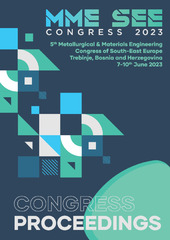Приказ основних података о документу
Characterization of raw peach stones and its biochar by SEM, FTIR and Raman spectroscopy
| dc.contributor | Sokić, Miroslav | |
| dc.contributor | Marković, Branislav | |
| dc.contributor | Manojlović, Vaso | |
| dc.creator | Šoštarić, Tatjana | |
| dc.creator | Kolašinac, Stefan | |
| dc.creator | Lopičić, Zorica | |
| dc.creator | Antanasković, Anja | |
| dc.creator | Adamović, Vladimir | |
| dc.creator | Avdalović, Jelena | |
| dc.creator | Bugarčić, Mladen | |
| dc.date.accessioned | 2023-10-29T20:52:21Z | |
| dc.date.available | 2023-10-29T20:52:21Z | |
| dc.date.issued | 2023 | |
| dc.identifier.isbn | 978-86-87183-32-2 | |
| dc.identifier.uri | https://ritnms.itnms.ac.rs/handle/123456789/968 | |
| dc.description.abstract | Growing industrialization and non-renewable resource depletion have a huge impact on alternative clean up technologies development, inducing investigation of the renewable, low-cost waste materials. Recently, lignocellulosic waste biomass, generated at a large scale by different industries, appeared as an attractive feedstock worldwide, due to its abundance, availability, multi-functionality and low cost. Since the fruits production has increasing trend all over the world, generation of lignocellulosic waste such as fruit stones (that represent approximately 1/5 of the total fruit mass) became a great environmental threat. In order to minimize negative impact on the environment, avoid greenhouse gasses emissions and help in resource depletion by its renewable nature, it is necessary to explore its performances regarding its wide application potential. Thermo-chemical conversion of lignocellulosic biomass in oxygen limited conditions, in order to get biochar, has received a lot of attention recently. The biochar production requires lower energy inputs and less expensive technology compared to activated carbon (estimation is that production cost of activated carbon are six times higher than biochar costs). In this paper, waste peach stones biomass was effectively converted into biochar at 500 °C under inert (Ar) atmosphere. Pyrolysis was performed in Nabertherm 1300 muffle furnace for residence time of 1.5 h, with a heating rate of 10 °C/min, while Ar was circulated through the sample at a rate of 100 mL/min. The raw biomass (PS) and obtained biochar (PS-B) with particle size 0.1 mm < dp < 0.5 mm, were characterized by Scanning Electron Microscopy (SEM), Fourier transform infrared spectrometry (FTIR) and Raman spectrometry to understand physicochemical changes which have been occurred after pyrolysis. SEM analysis revealed the increased surface area due to the visible augmentation of pores and roughness. FTIR analysis showed that many bands present in native biomass cannot be observed in biochar, due to the conversion or removal of the most of the functional groups. Prominent bands have confirmed presences of aromatic compounds in biochar: at 1592 cm−1 (C=C bond stretching derived from aromatic rings in the lignin), 1030 cm-1 (alcohol C-O stretching vibration) and in the region 900 to 700 cm−1 (originating from aromatic compounds). These finding are in accordance with results from Raman analysis, where D and G bands (at 1350 cm-1 and 1580 cm-1 respectively), indicate the presence of poly-aromatic hydrocarbons. Thermo-chemically modified biomass like this has a great application potential: as a pollutants sorbent, biofuel, soil amendment, biocarriers, and in construction and electronic industries. | sr |
| dc.language.iso | en | sr |
| dc.publisher | Belgrade : Association of Metallurgical Engineers of Serbia | sr |
| dc.relation | info:eu-repo/grantAgreement/MESTD/inst-2020/200023/RS// | sr |
| dc.rights | openAccess | sr |
| dc.source | 5th Metallurgical & Materials Engineering Congress of South-East Europe MME SEE 2023 | sr |
| dc.subject | peach stones | sr |
| dc.subject | pyrolysis | sr |
| dc.subject | biochar | sr |
| dc.subject | SEM | sr |
| dc.subject | FTIR | sr |
| dc.subject | Raman | sr |
| dc.title | Characterization of raw peach stones and its biochar by SEM, FTIR and Raman spectroscopy | sr |
| dc.type | conferenceObject | sr |
| dc.rights.license | ARR | sr |
| dc.citation.epage | 241 | |
| dc.citation.spage | 237 | |
| dc.identifier.fulltext | http://ritnms.itnms.ac.rs/bitstream/id/2047/bitstream_2047.pdf | |
| dc.type.version | publishedVersion | sr |

